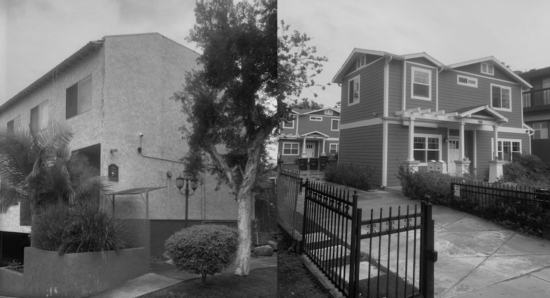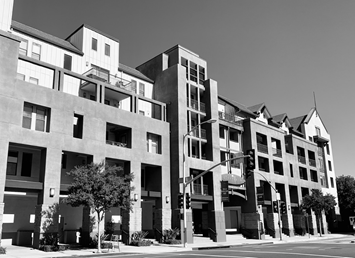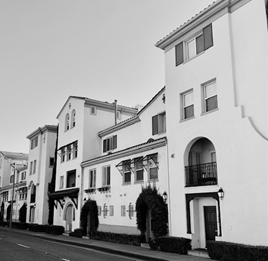 This is the ninth in a series of columns on 10 Grand Challenges to transform Pasadena’s future. Today’s column focuses on ensuring that new apartment and condo projects reflect Pasadena’s traditional quality of design.
This is the ninth in a series of columns on 10 Grand Challenges to transform Pasadena’s future. Today’s column focuses on ensuring that new apartment and condo projects reflect Pasadena’s traditional quality of design.
Regardless of local sentiment, Pasadena is going to see the development of more high-density housing in the years to come. Prominent city leaders may lament the loss of “local control” but the Council has unanimously signed off on a legally-binding plan that enables the construction of at least 9,429 units of new housing by the end of 2029.
So the issue isn’t quantity. It should be quality.
We’ve all seen too much schlock – projects sprouting up that are not simply ugly, but poorly-designed. They are a standing insult to surrounding neighbors – hostile to pedestrians and constructed with materials that nearly immediately start to corrode. Their developers clearly are more focused on their profit margin than the quality of life of the people who will live in what they build.
Why? After all, Pasadena prides itself on robust process and community input. Projects often go through years of review, including multiple stops at the City’s Design Commission. It can’t be we don’t have enough rules – the City’s Zoning Code is 289,000 words long. If every project has to go through rigorous review, why is there such a wide range of results? Why are some projects beautifully designed – and others are, to be blunt, crap?

Obviously, architects and developers vary widely both in their talent and their commitment to quality. The City can’t control that. But the City can have something it currently lacks: clear, consistent, objective design standards.
Of course some question whether it is possible to write enforceable rules. They insist that architecture is “creative.” They claim objective standards will stifle creativity.
It’s a misplaced concern. First, the buildings in the most cherished places in the world are remarkably uniform. New York brownstones, San Francisco “painted ladies,” Pasadena bungalows and Paris apartment buildings have a rich variety of details, but they all conform to basic rules of form. Second, Southern California developers are not hiring design geniuses to create works of art – they are hiring firms to deliver standard products that can be conventionally financed and produced efficiently and profitably. Third, clear standards don’t prevent artistic creativity any more than the frame of a painting or the stage of a play limits the imagination of a painter or a playwright.
Pasadena already has three decades of successful experience with objective design standards. Back in the Seventies and the Eighties, “six pack” apartment and condo projects were replacing bungalows and Victorians throughout central Pasadena. Those hideous monstrosities had half buried carports or garages with two story blank walls fronting the street that towered an additional half story above the sidewalk to accommodate the parking. They had miserable three-foot wide walkways along one property line and twenty -foot driveways on the other.
Neighbors complained about the density. But older “garden apartments” and bungalow courts that fit in well with those neighborhoods were built at the same density. The problem was design.
The “City of Gardens” Ordinance was adopted in 1989 with standards that mandated every project have a minimum shared open space, typically a courtyard or garden. Even without reducing the parking standards, it radically transformed new projects to be far more inviting to the streetscape. It also made for more green and livable places to enjoy. While it has been diluted over the years, there is an almost night and day contrast between the projects built under the old zoning rules and the ones built under the City of Gardens standards.
The City of Gardens applies only to projects that are typically two or three stories. Most projects being built now in Pasadena are five, six or seven stories. Pasadena is now embarking on writing new rules for those higher density projects. To draft them, the City has hired the renowned firm of Moule and Polyzoides, located in town, but nationally recognized for their design excellence.

Earlier this month, Pasadena Planning Commissioners and staff (along with some dedicated community members) toured a dozen large projects built recently to see up close what works – and what doesn’t. It was a remarkably productive Saturday morning adventure. No project is perfect – and none is a complete abomination (although a few come close). Some issues are glaringly obvious – how parking is handled is one. But building massing, street frontages, quality of materials and design details like window treatments all play a role in how a project fits into the neighborhood context and how well it functions as a place to call home.
One of Moule and Polyzoides lead designers, Vinayak Bharne, maintains there are three dimensions for effective design regulation. The first goes to the building type, placement and shape. Our current zoning code uses crude (and counter-productive) formulas – the number of units per acre and something called “floor area ratio.” Neither has anything to do with design integrity and how the building relates to its surroundings. Objective standards can determine how parking is handled (with an ugly block-long grate next to the sidewalk or tucked behind or underground); whether the street is lined with front stoops or blank walls; and whether the building is a blank box, a riotous mishmash of arbitrary “modulation” or a coherent building type.
The second dimension of design standards, Bharne explains, regulates the architectural quality of new projects. This is not a matter of aesthetic taste or style. Planning Commissioners saw first hand that whether a window is flush with the exterior wall or slightly recessed makes a significant difference – as does the contrast between durable and authentic materials and pasted on fake wood and brick. Setting objective design standards can dramatically improve the built product.
The third and final dimension can allay some of the random ugliness of so many new projects. Without specifying a specific style (think Santa Barbara), Pasadena can at least insist that buildings have a coherent design approach. One of my least favorite buildings from the Seventies is on Allen Avenue just north of Colorado. Nearly a block long, it incorporates cheap wood cladding to mimic Elizabethan half timber homes. No one is fooled. You don’t have to be a snob to appreciate the difference between an authentic Spanish Revival building and Taco Bell architecture.

As a job center with an affordable housing crisis, Pasadena needs more housing. Both because of State law and Pasadena’s new Housing Element, a lot more housing is going to get built. Now is the time to insist that those buildings incorporate the timeless qualities that make life livable for future residents – and bearable for existing neighborhoods. Objective design standards will safeguard our heritage and ensure the new compliments the old.
Rick Cole is a current Pasadena Planning Commissioner and a former Mayor of Pasadena. He serves as Chief Deputy Controller for the City of Los Angeles.
See Also: Rick Cole: Ten Grand Challenges to Transform Pasadena’s Future – Pasadena Now
- Remove the concrete channel from the Arroyo:the beautiful valley running through our city is one of our greatest assets. Back in the Thirties, our default for handling periodic flooding was with engineering. We now know how to divert storm water to percolate back into the ground instead of flushing it out to sea. Removing the ugly channel would create a completely different feel to the lower Arroyo, Pasadena’s pre-eminent natural recreational gem
- Remove and reclaim the 710 stub:Caltrans deliberately dug a huge hole and filled it with concrete to push traffic into residential neighborhoods in a failed attempt to force South Pasadena to surrender to the bulldozers. Now that the City of Pasadena has title to the property, we can eliminate this scar on the landscape and build parks, affordable housing and community assets to reknit the southern part of our city.
- Connect Old Pasadena to PCC with a streetcar:There is Federal funding to route a street car loop on Union and Green that would connect our historic core with the Playhouse District, South Lake and a campus with 30,000 students. It would link our greatest assets (Caltech would also be in walking distance) to the regional light rail stop at Memorial Park and make navigating between them easy and non-polluting, reducing traffic.
- Transform the Central Library into a 24/7 Learning Center: Life-long learning doesn’t just take place in formal schools — libraries have always been a place providing access to people of all ages and incomes to access learning. Books are just one form — but classes, maker spaces, speakers, conferences and activities could enliven the classic building which needs over $100 million in seismic upgrades which shouldn’t just be spent to put back books.
- Create an Affordable Housing Authority:The City, School District and PCC should partner to use all available public land for creating workforce, student and affordable housing. With State mandates to build 6000 units of affordable housing in Pasadena over the next eight years, the public sector should take the lead to ensure maximum benefits to our local residents.
- Replace outdated zoning with a new design code:Pasadena relies on a Design Commission to guide development of higher density apartments and condos — and the results are less than wonderful. The State now insists on “objective standards” — but Pasadena doesn’t have them for its high density development. Let’s make sure new development to provide needed housing is also compatible with our community’s high standards for design. The issue is not just how they look, but more importantly, how they function to compliment the neighborhoods around them.
- Individualize help for the homeless:Community Solutions, a nationwide program based on extensive research, advocates for a “by name” registry of those accessing public and non-profit services so unhoused individuals and families aren’t bounced around uncoordinated programs and agencies. Sharing data can ensure the homeless get the help — and housing — they need, quickly and humanely.
- Convert to carbon-free energy:Pasadena 100 is pushing our public utility to walk the walk of its environmentally-friendly talk by eliminating coal and natural gas from electric generation by 2035. With strong Federal support for renewable energy, it’s clearly doable — so why isn’t Pasadena leading?
- Establish car-free zones:The pandemic has transformed many streets around the world into pedestrian zones that now are full of life and people. Businesses and residents love it! Let’s start with weekends and shut down Colorado between Fair Oaks and Pasadena Avenue. Or South Lake between Del Mar and California? Or the Colorado Street Bridge. Nearly everyplace it’s been tried, including here in Southern California, it is quickly so popular it goes year-round.
10. Make Pasadena bike-friendly: Countries like Holland and cities from Davis to Paris used to be unsafe and unattractive to bicyclists. Skeptics doubted that people would bike — but when protected bike lanes connect where people want to go, the shift happened more quickly than anyone imagined. Biking is cheaper and healthier for individuals and the planet. Why does Pasadena lag cities in the region like Long Beach, Santa Monica and Culver City?


















